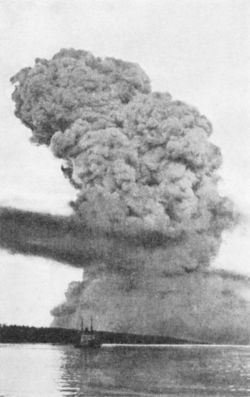The Largest Man-Made Accidental Explosion

On December 6, 1917, an explosion ravaged Halifax, Nova Scotia, killing 2,000 people and injuring 9,000 others. But this mass disaster was not triggered by natural events. The explosion was, entirely, man-made.
Just before 8:45 A.M. on that day, the SS Imo, an empty Norwegian passenger and freight ship, and France’s SS Mont Blanc, collided. The Mont Blanc, a cargo ship, was loaded with munitions aimed at supporting French efforts in World War I. The Mont Blanc caught fire, and while its crew safely made it to shore, the language barrier — them, French; native Halifax residents, English — probably prevented any warnings given from being heeded. Twenty minutes later, amid hundreds of onlookers, the Mont Blanc’s payload caught fire. The ship exploded, as pictured above.
The explosion’s intensity was roughly one-fifth that of the atomic bomb which struck Hiroshima. The Mont Blanc itself was instantly vaporized; a fire plume shot up over a mile in the air. Roughly one square mile around the blast area was destroyed and rendered uninhabitable, while structural damage to buildings was recorded as far away as ten miles from the epicenter of the explosion. An earthquake-like shake was recorded 75 miles away and the explosion could be heard over 100 miles north and 200 miles west of the blast. The blast was so powerful that a half-ton piece of the ship’s anchor shaft shot through the skies, landing over two miles from where it came. (The fragment is now part of a monument placed roughly near its landing spot, as pictured here.)
The after-effects were also considerable. The explosion set off a tsunami, which struck the waterfront with 60 foot high waves. It also caused a black, sooty “rainfall” for ten minutes after the blast; survivors were covered in debris. And the Canadian military lost one of its key buildings, as the Royal Naval College of Canada was destroyed in the explosion.
The catastrophe is widely considered the worst man-made accidental explosion in history when factoring in not just the size of the blast but also the number of casualties, the radius of the damage, and the loss of property. The death toll was so immense that more Nova Scotians died in the explosion than otherwise in World War I.
Bonus fact: The Mont Blanc (cargo ship) got its name from the Alpine mountain of the same name, on the French and Italian border. In 1886, Theodore Roosevelt led an expedition to its peak — while vacationing in Europe on his honeymoon.
From the Archives: Hey, Let’s Crash Two Trains Together!: Another man-made disaster… but not an accident.
Related: “Blizzard of Glass: The Halifax Explosion of 1917” by Sally M. Walker. Available on Kindle.

Leave a comment